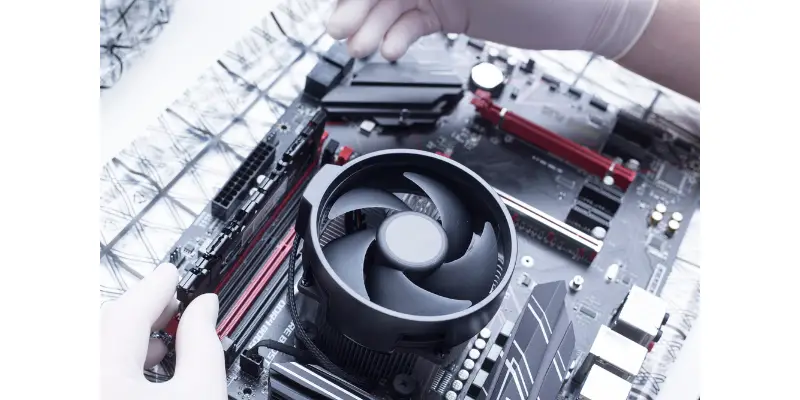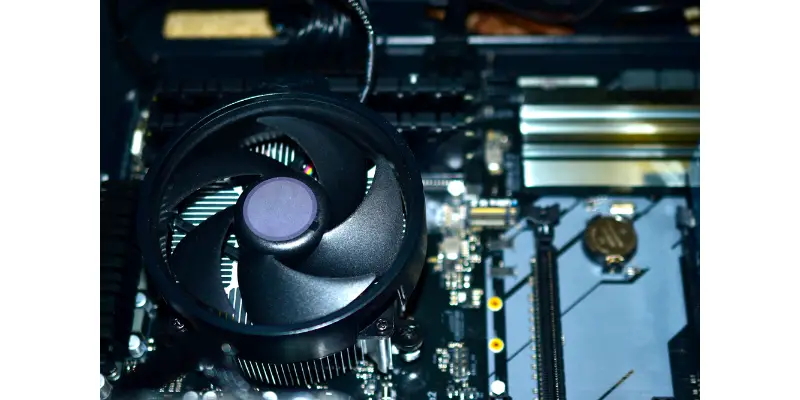Disclaimer: This post may contain affiliate links, meaning we get a small commission if you make a purchase through our links, at no cost to you. For more information, please visit our Disclaimer Page.
There are a lot of things that can go wrong with a computer. One of the most common problems is a malfunctioning fan. So this article will talk about some common questions people ask about CPU fans.
A CPU will come with a built-in fan that helps to dissipate the heat produced by the processor when the computer is active. Without the fan, your CPU will get damaged due to the resulting high temperature. So, it is important to keep the CPU fan clean and obstruction-free.
Table of Contents
Why Do CPUs Have Fans?
If you ever open up a computer and inspect the motherboard, you will notice a big box with a fan attached to the processor. This is what we refer to as the CPU cooling fan. And as the name suggests, its purpose is to keep the CPU cool.
Normally, when you run your computer, a common by-product is heat. Pretty much all the internal hardware such as the graphics unit (GPU), RAM, CPU (processor), etc. will generate some heat. This heat will increase the core temperature of those components. And simply put, these components will start to falter at a certain temperature.
To avoid such a catastrophe where all the hardware malfunctions, every computer has a cooling system. And part of that cooling system, be it air-based or liquid-based, is one or multiple fans.
Every cooling system has a “heat sink” which drains the heat from the internal components. This heat then goes to the radiator. Finally, the radiator takes in the heat and the fans disperse it away from the computer. This is why fans are such a vital part of the cooling system.
Can You Use CPU Without Fan?
Technically, you can run a CPU without the fan as the fans have no role in the internal mechanisms of a processor. However, this will only last for a short amount of time, as the processor is not sustainable without the fan.
Essentially, the internal structure of the CPU will get fried due to the high temperature. And it does not take long for the CPU to get dangerously hot. Once that happens, it is pretty much impossible to recover the processor. This will leave you no choice but to buy a new one.
Now, you may imagine a liquid-cooled computer system and think that you can run a CPU without fans perfectly. However, take one good look at a liquid cooling system and you will realize that it even integrates the use of fans.
Liquid cooling systems also utilize a radiator, which mediates the transfer of heat between the liquid and the environment. And that radiator will have a fan that propels the heat away from the cooling system.
Will Fans Spin Without CPU?
The CPU fan can spin even if there is no CPU proper. The fan’s job is to cool down the CPU. But it derives its power from the motherboard, not the processor. Usually, you have the fan wire, which you need to attach to the CPU fan header located on the motherboard. The fan header is the designated port where you need to insert the fan.
Since the CPU and the fans are powered separately, the fans should run without the CPU, provide that the motherboard has power. Now, remember that your computer will not work nor can you test the full extension of the motherboard without a CPU.
But if you plug the motherboard into an appropriate power supply, it will carry electricity throughout its circuitry. This gives you the chance to test the LEDs and cooling system of the motherboard without needing a CPU installed.
Note that the fan’s connector has to be attached to the fan header for it to receive power. And make sure that the motherboard is connected to a stable power source.
Which Way Does a CPU Fan Blow?
A CPU fan will allow for unidirectional airflow, meaning the air blows in only one direction and never the other way around.
Now, every fan has two sides to them. One is the import side, which draws in the air basically like a vacuum. On the other side, you have the exhaust, which pushes the air away from the fan.
Now, remember that the fan wants to draw in the air from the CPU and carry it away. So, the import part should face the processor while the exhaust side should face the opposite way. Then the hot air will come out of the CPU and be dispersed into the surrounding air.
Usually, there is an arrow sign that indicates which way the air flows inside the fan. But another common trick you can use to identify the direction is by looking at the protective bars. The exhaust side, which is also the fan’s rear end, will have protective bars or grills. You can use that to easily identify which side is which.
As for the direction of the propeller, they move in a counter-clockwise direction if you see them from the front. This allows it to bring in the air instead of dispersing it.
Can You Use a CPU Fan as a Case Fan?
You can use the CPU fan for your case as long as they both have the same fan header on the motherboard. Otherwise, the fan will fail to power up.
But you should always remember that both the CPU and Case fans are equally important. You will not be able to get by just using one of them. Because they serve two different purposes even though their mechanism is identical.
The CPU fans pull the heat from the processor and release the heat inside the case. The case fans create and maintain an airflow inside the case, which will remove the heated air from inside of the casing.
If you only use the CPU fan, the cooling will not be as efficient. Because you are only taking the heat from the processor and placing it inside the case. This will still heat up the internal hardware and that will, in turn, decrease your PC’s performance.
Do CPUs Come with Fans?
Every factory-made CPU will come with a fan already attached. We call this a “stock CPU fan”, which is usually of lower quality. Since a CPU needs a fan to function properly, an accompanying fan is a must.
When you get a custom-made PC, you have the option of selecting a high-quality CPU fan with your CPU. You can attach it separately or have the manufacturer attach it for you.
You can also get aftermarket CPU cooling fans that are sold separately from the CPU proper. Make sure these are sufficient enough to provide cooling for your specific PC built. Otherwise, you are just wasting money and effort.
How Long Do CPU Fans Last?
The answer to this question varies so drastically that it is hard to give an exact number or even a general range. Depending on the quality of the fan and how well you maintain it, it can last anywhere between a couple of years to even a decade.
Most standard fans will last for 5 to 6 years if you clean them regularly. Dust particles and other debris can clog up the propeller which will damage the integrity of the fan.
Also, if you frequently overclock your hardware, you may end up shortening the lifespan of the fan. Because when you overclock the CPU, you generate much more, consume much more power, and generate much more heat than normal. To compensate for this excess heat, the fans also have to work even harder. Thus, increasing the chance for it to go bad quicker.
Conclusion
CPU fans are integral for making the CPU function properly and ensuring that it lasts for a long time. So, it is equally important that you clean the fans on your computer regularly. Maintaining the fans is a big part of taking care of a computer.


